Historic RARE Antique WWII Army 76th Armored Medical Battalion Sign, PATTON
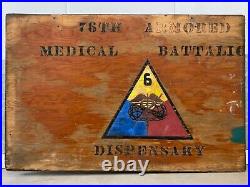
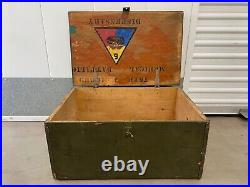
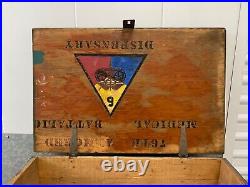
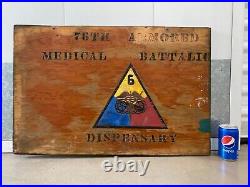
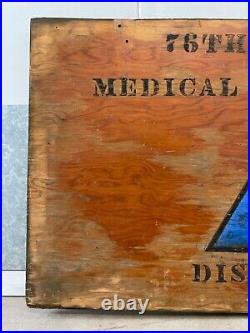
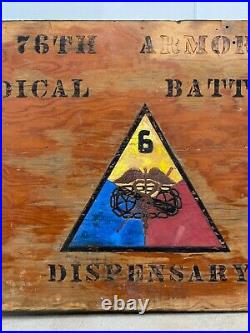
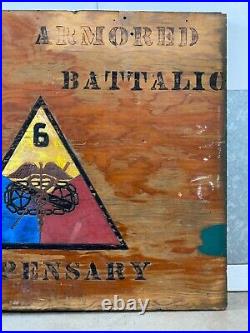
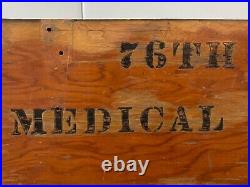

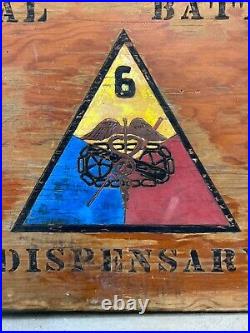

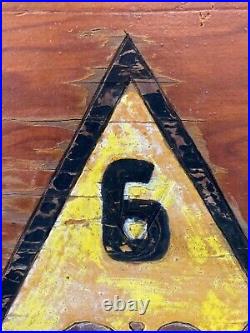
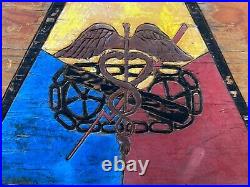
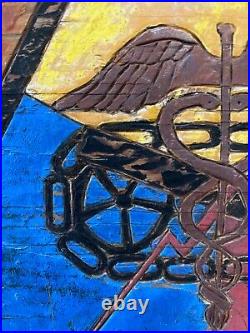
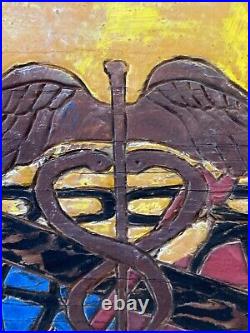
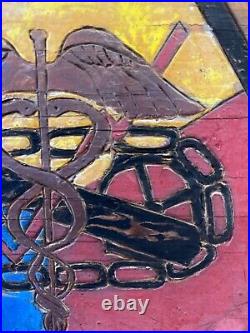
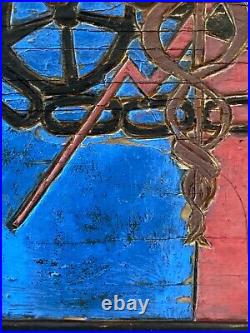
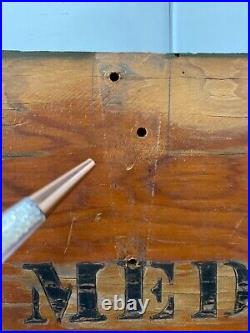
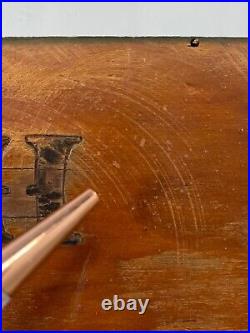
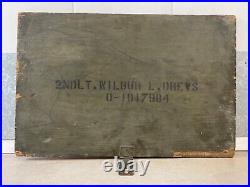
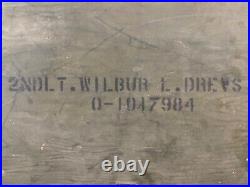
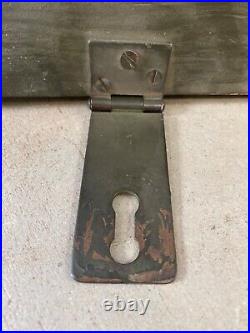

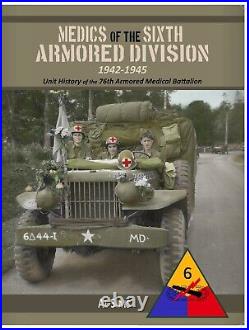

This is a historic and Historic RARE Antique WWII Army 76th Armored Medical Battalion Sign, painted and carved on wood, representing the medical battalion attached to General George S. Patton's famous Super Sixth. This medical battalion treated the wounded on the frontlines at the Battle of the Bulge and were some of the first soldiers to enter the liberated Buchenwald concentration camp, to treat the sick and wounded Holocaust survivors. This sign reads: "76th Armored Medical Battalion Dispensary, " and has the unique crest of the 6th Armored Division, with the caduceus medical symbol superimposed over it. This crest is intricately carved by hand and painted. This sign appears to have been repurposed by the United States Army, and made into the top lid of a soldier's footlocker, who was from a completely unrelated regiment. On the verso of this sign is the soldier's name stenciled in black paint, 2nd LT. This soldier actually served in the Pacific Theatre, and later became a police officer for the city of Burbank, California after the war. The rest of the trunk is not included, due to its historical irrelevance to this piece. Approximately 17 x 25 5/8 inches, and 3/4 of an inch thick. Good condition for age, with some light scuffing and edge wear. The fact that this rare sign was repurposed as the underside of a lid for a U.
Army footlocker is likely the only reason that it survived to this day. You will not see another one. If you like what you see, I encourage you to make an Offer. Please check out my other listings for more wonderful and unique artworks! About the 76th Armored Medical Battalion and the 6th Armored Division.
The mixture of insignia and distinctive colors of several arms incorporated in the Armored Force symbolize integrity and esprit. It is an interlocked ornament, found in Nordic monuments, composed of three torques: red for Artillery; blue for Infantry; and yellow for Cavalry. The symbols represent the characteristics of Armored Divisions: the tank track, mobility and armor protection; the cannon, fire power; and the red bolt of lightning, shock action. The 6th Armored Division was one of General George S. Patton's famous Third Army divisions during World War II in Europe.
Its post-war alumni association disbanded at its final reunion in Louisville, KY in September, 2000. The 6th Armored Division was created February 15, 1942 at Fort Knox, Kentucky and was made up almost entirely of citizen draftee soldiers. Its training stations were Camp Chaffee, Ark. Louisiana Maneuvers, the Mojave Desert, and Camp Cooke, CA. It arrived in England in February 1944 and landed at Utah Beach on July 18, 1944.During the next 9 1/2 months, the 6th Armored fought in five major European campaigns of World War II. The majority of this time was spent in General George S. Patton's famous Third Army. The 6th Armored was deactivated September 18, 1945 at Camp Shanks, New York.
In 1947 the Sixth Armored Division Association was organized to perpetuate the memory of 1,274 fallen comrades, to assist in promoting an everlasting peace, and to serve as a medium of contact among the men who served in the division. Its first reunion was held in 1948 in Louisville, KY.
On September 12-17, 2000 its 53rd and final reunion occured in Louisville. You know the 6th Armored Division.You may not recognize the name "Super Sixth", but if you know anything about World War II in Europe, you know about the 6th Armored Division. If you've ever heard about Patton's Third Army, or watched the movie "Patton", or if you've ever heard about the period known as "The Battle of the Bulge", "The Ardennes Campaign", or sometimes just "Bastogne", you know about the Super Sixth. If you've ever heard about "The Breakout" from Normandy hedgerow country a month and a half after D-Day, or Patton's race across France, or the Third Army's 90-degree turn to the north to the Battle of the Bulge, or the crossing of the Siegfried line, or the liberation of Buchenwald, then you probably know more about the 6th Armored Division than you realize.
Praise by a former enemy is a high honor, and after World War II German Major General F. I think that Patton would have done better if the 4th and 6th Armored Divisions had been grouped together in a single corps, reinforced possibly by the French 2nd Armored Division.These were all very experienced formations and ably commanded... Combined as a tank army under one commander, these three armored divisions might well have achieved a decisive breakthrough. He also praised the 6th's performance at Han-sur-Nied, calling it "a dashing coup-de-main". The 76th Armored Medical Battalion was a 1,000-man unit which was responsible for providing medical service for the 10,-man Sixth Armored Division.
The 76th consisted of HQ, HQ Company and three letter companies, Company A, Company B, and Company C. The letter companies were each assigned to the three Combat Commands, CCA, CCB, and CCR (Combat Command Reserve). In the reorganized (1943) Sixth Armored Division a combat command was roughly equivalent to a brigade. Cecile Callahan - 76th Armored Medical Battalion. I was one of the first to go inside Buchenwald, one of Hitler's concentration camps.
Some people may disagree that the Holocaust even took place, but Cecil Callahan will disagree -- he was there. The 95-year-old Grayson native served in World War II for 23 months between 1943 and 1945, and might be one of the few veterans still living who witnessed the horror inside Buchenwald, a concentration camp where the largest number of European Jews were killed during the Holocaust. "I was a medic with the 76th Armored Medical Battalion, 6th Armored Division, under the direction of General George Smith Patton III, " Callahan recalled recently while seated in his patriotically decorated home.
I was a leader in charge of taking care of the wounded and dying during the Battle of the Bulge, the major battle during World War II. Was so cold all the time.
In this battle, 25,000 soldiers had frozen feet. While leaving behind a wife and children, the then 29-year-old Callahan answered his draft call to the war and headed overseas on the Queen Mary - to a place where he would never forget. "I was one of the first to go inside Buchenwald, one of Hitler's concentration camps, " he remembered. There was only one live person inside there strong enough to talk."One Sunday night we had so many dead they were stacked like railroad ties, " he said. I still wonder how so many of them were still alive.
There were woodbins filled with the dying, and a lot of them were burned alive. I just don't know why it was allowed to go on for so long. The odor of burned bodies is something you can never forget.
Smell it sitting here today. During his time serving as a medic, Callahan witnessed hundreds of fellow soldiers dying from war-related injuries. While being much older than many of his comrades, Callahan was known to most as Pop.
"I was helping to take care of this little boy (younger soldier) one day, " he said. We had to take his leg off. But he died, and I was holding his cut-off leg when it happened. We tried, but we couldn't save him. "Every hour and every minute of the day we were trying to save a life, " he said.
It was certainly nothing to laugh at. I could sit here a week and tell all that I saw - and a lot of it wouldn't be good. But I was glad to have been in the group that helped to liberate Buchenwald. To tell you the truth, the Germans starved those people to death. Feed them for days and then set a plate of food outside a door and open it. They laughed when those poor people trampled one another to death trying to get a bite of food. Callahan said he also witnessed the deaths of thousands of women and children."Some of it was really hard to see and accept, " added during his sad recollections of the war. "I've had some people to say, "That Callahan's out telling awful tales about the concentration camp, and none of it is true.
I saw it with my own eyes. You can never forget watching women and children being put in train boxcars and drove. Up to a trench and thrown off and buried alive. Despite the horrible memories of WWII, Callahan remains proud to have served in the Army. "You just didn't know what to expect from day to day, " he said.
They (troop leaders) would dig a big hole and tell you to get down in it and then they would drive over you in a big tank. Or, they might have you to dig a really huge hole and then turn around and make you fill it back up -- That was training. Although, he said during the two years overseas, his thoughts remained in Carter County with his family and friends. "That's all that kept me going, " he said. I just spent a lot of time thinking about my wife and children. It was so cold over and our boys were dying off right and left. It was just really different. I will just say there were no warm beds or covers from home. Meanwhile, letters from home also helped to make the snowy days and frigid, cold nights a little easier. She had written 24 letters and they all arrived together.They also were homesick, too. Some asked if they could read mine - I let them. Callahan can recall one particular gift sent overseas from a relative. "My sister made me a Christmas cake, " he said. But it had molded before it got to me.
One other detail, Callahan will never forget is the day he learned he would be returning home. "We were put in a truck and driven all night, " he remembered. We didn't know where we were going, but the driver did. I could see lights close to the harbor. We thought we might be going to Japan.It was about daylight and we then ended up being interviewed and given clean clothes. The commander then said,'There is no work for you. If you are good the rest of the day, you will see the Statue of Liberty soon. See that boat over there?
It's the Queen Elizabeth and going to take you back to the states. The proud veteran still smiles when asked about his time in the Army. "I'm seated here doing very well, " he continued. My mind is good, and I feel pretty good.
When some folks start grumbling about past and present wars, I tell them if we hadn't gone over there, we wouldn't all be here today. I'm just thankful to God that I'm still here and can tell people about the concentration camps, some folks still say it all didn't happen - Well, I know it did.